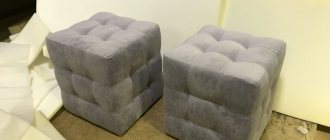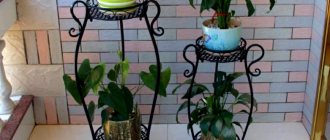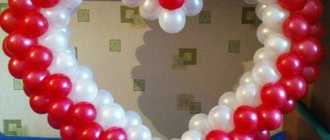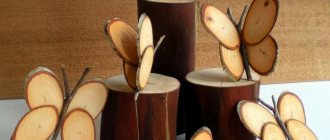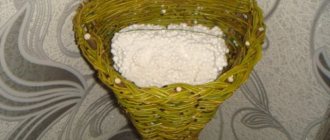children's sandbox
Sand is one of nature's best toys. Children's imagination is enough for the most incredible ideas, from a formidable castle to a birthday cake. The sandbox has no rules, allows children to formulate and test hypotheses, provides sensory experiences that benefit language development, and is a great opportunity to learn physical and social skills.
However, in this article, let's look at not why, but how to make a children's sandbox with your own hands . This would seem to be a very simple design, but it turns out there are many options and nuances. Here are only two dozen simple homemade sandboxes with step-by-step photos and a brief description; you only need desire, imagination and a few hours of free time.
Tips for making and placement
You need to choose the location for installing the future sandbox and the materials for its manufacture, taking into account the following factors:
- Children, even those who are passionate about play, need supervision. Therefore, the sandbox must be installed so that the child is always in sight of adults.
- The sun's rays can harm a child's health, leading to sunstroke and burns, but solid shade is not the best option. Therefore, it is advisable to place part of the sandbox in the shade, and part in the open, so that the sand can dry out after rain.
- Drafts and excess moisture also negatively affect children's health. Therefore, the sandbox should be located away from water and not exposed to the wind.
- Trees, especially old ones, often fall into dust and dry leaves. Therefore, in order to avoid sand contamination, it is better to install the structure away from them.
- Some plants cause allergies, and some attract stinging insects. Therefore, you need to make sure that there are no honey plants or plants that cause allergies nearby.
- Well-processed wood and reliable fastenings will help avoid splinters and injuries.
- Hard materials such as stone, brick or iron can also cause harm, so it is advisable to avoid using them. And of course, you need to make sure there are no sharp corners, nails, cords, and so on.
In addition to the entertainment function, playing with sand has a developmental and psychological function. Soft bulk material calms and relaxes the nervous system, promotes the development of creativity, fine motor skills, and perseverance.
Choosing the right sand
River sand is usually used for children's games. The edges of its granules are polished with water and are not capable of injuring, moreover, there are almost no foreign impurities in it. If you decide to buy quartz sand, this can be done in shopping centers specializing in building materials. Any sand must first be sifted before pouring into the sandbox bowl.
Note!
There is a special mixture for the playground; it is well suited for sculpting figures, since it additionally contains clay. Special fragrances are added to it to repel animals and insects from the sandbox.
There are many different ways to decorate a sandbox and make it more attractive to young children. The main thing in this case is the ability to show your imagination and not be afraid to embody ideas. And then your playground will become your child’s favorite place to play.
Preparatory work
Considering all of the above, it is more convenient and practical to make a deep wooden sandbox with a lid.
Drawings and dimensions of a children's sandbox
Initially, you need to decide on the dimensions of the future structure. If there are a lot of children and there is enough space on the site, then you can make a large sandbox measuring 2x2 m. For one or two children to play, it is enough to make a square structure measuring 1.5x1.5 m.
Despite the simplicity of the design of the future sandbox, it is better to have a visual diagram before your eyes. Thus, you first need to draw a drawing that will help you decide on the necessary materials and correctly calculate the dimensions and quantities.
Looking at the drawing, you can see that the side boards on both sides should be slightly longer in order to form the correct closed corner.
How to choose material
Consider the following facts:
- Tree is different from tree. The durability of a structure may depend not only on the quality of processing, but also on the type of wood: pine, linden or larch are less susceptible to rotting.
- The sides of the future design must withstand heavy loads. To ensure strength, it is necessary to use boards with a thickness of at least 30 mm.
- Sanding and sanding an already assembled structure is extremely inconvenient. It is advisable to sand the prepared parts well and treat them with an antiseptic before assembly, which will avoid unprotected areas. It would be prudent to paint the iron hinges in advance as well.
- The main thing is not to forget what’s inside. The sand must be clean, free of foreign impurities, and mold well. Therefore, it is better to give preference to river or quartz sand, having first sifted it through a fine sieve, which will help get rid of dust, possible insects, and foreign objects.
Materials and tools (for a structure measuring 1500x1500 mm)
When purchasing materials, one cannot discount the presence of a foundation. To build the foundation you will need:
- expanded clay, small stones or river pebbles for drainage;
- agrofibre, dense polyethylene or plywood sheet.
The basis of the sandbox is a frame with sides 1500x1500 mm. To make the frame you will need:
- timber 50x50x450 mm (for corner elements) – 4 pieces;
- beam 50x50x1000 mm (for strengthening corners) – 1 piece;
- board 30x150x1500 mm (short side walls) – 4 pieces;
- board 30x150x1560 mm (long sides) – 4 pieces;
- seal - 1620mm;
- self-tapping screws 45 mm - 50 pieces.
The transforming cover will be attached to the finished frame. For it you need to prepare the following materials:
- board 20x125x1560 mm - 12 pieces;
- timber 30x30x250 mm (for fastening the seat) – 4 pieces;
- timber 30x30x450 mm (to strengthen the back) – 4 pieces;
- hinges (canopies) 40 mm - 12 pieces;
- self-tapping screws 45 mm - 50 pieces;
- self-tapping screws 25 mm - 60 pieces.
For processing and registration you need:
- antiseptic for wood processing;
- wood primer;
- paint or varnish for coloring.
The materials are ready, but without tools the process will not move forward. Therefore it is necessary:
- roulette;
- pencil;
- pegs with a rope tied to them;
- shovel;
- hacksaw or jigsaw;
- sanding machine or sandpaper;
- drill and drill bits;
- screwdriver or set of screwdrivers.
Nuances of the construction process
Having carefully double-checked the drawing of the children's design, according to the chosen scheme, they proceed to the purchase, cutting and preliminary preparation of the material.
Material
Wood is the most commonly used material for making children's structures. With proper treatment and timely preventive maintenance, a wooden sandbox will last more than 10 years. Parts cut according to prepared drawings are coated twice with a water-polymer emulsion.
Note! Elements of the children's sandbox that will be in the soil are treated with bitumen mastic.
If you do not plan to use the children's sandbox for a long time, you can use aspen or alder to make it. Coniferous trees will help increase the service life. For construction it is convenient to use quarter or tongue and groove boards. How to assemble a box from them is clearly shown in the following diagram:
Step-by-step instructions: making and installing a wooden sandbox with a lid
It is better to carry out the work in several stages. First of all, it is advisable to assemble the frame of the sandbox, then make the base and install the box in the prepared place. And only after that install the cover.
Housing assembly
We fasten the sanded and antiseptic-treated boards together in a square shape using corner elements - long bars, not forgetting to first mark and drill holes for the screws.
If you glue regular insulation between the first and second tier, the boards will fit closer to each other and sand will not spill out into the cracks.
To give greater strength to the future sandbox, you need to securely secure the corners with the help of additional bars.
Construction of the base and installation of the frame
The area chosen taking into account all the tips and recommendations is leveled and cleared of debris. For more accurate markings, it is necessary to add 15–20 cm on each side to the dimensions of the future sandbox. We make markings using pegs with a rope stretched over them, checking the correctness of the angles.
We remove the top layer to a depth of approximately 20–25 cm, making a slight slope towards the center. This is necessary so that water that gets into the sandbox does not accumulate, but ends up in the drainage. In the center we make a hole with a diameter of about 50 cm and approximately the same depth. We fill it with the material prepared for drainage.
Then you need to pour a five-centimeter layer of sand and compact it thoroughly.
On the resulting “pillow” lay the base itself, which can be made of different materials. The main thing is not to forget to make holes in it at a distance of about 10 cm from each other, again to prevent moisture accumulation.
We install the finished frame on the resulting base. Now you can proceed to the main stage.
Installation of a cover that transforms into seats
We thoroughly screw two boards on each side to the sides. Then we proceed to assembling the moving parts of the lid. To do this, we fasten the remaining boards in pairs using bars.
The elements obtained from the first pairs will serve as a seat, and the elements with long bars will serve as a backrest. The protruding parts of the beam will serve as a support, preventing the backrest from reclining.
We attach the “seat” element to firmly screwed boards using three loops located at the same distance from each other. The hinges should be on top, and the bars connecting the seat boards should be on the bottom.
We attach the backrest to the seat, also using hinges, not forgetting that this time the hinges “look” inside the box, and the bars are on the outside.
In this version of the assembly, the last stage is quite problematic, because the back part has to be screwed in almost by weight. There is another way. First fasten the back and seat together, and only then put them on top of the box and attach them to the rigidly attached boards.
Attention! To avoid possible injuries, it is important to “drown” the screw heads. You should also check that the lid opens and closes easily.
Final finishing
So, the sandbox is ready! Now it is advisable to smooth out possible corners with sandpaper or a grinding machine. After this, even if all the wooden and iron parts have already been treated, it is better to go through the antiseptic again.
You can simply varnish the resulting structure, but it is best to paint it. And here fantasy comes to the rescue. Don't forget that this is a children's play area. And kids really love bright colors. Color the sandbox with different colors. Additionally, you can draw patterns, funny pictures by hand or apply using a stencil. The main thing is that the children are happy and feel comfortable in the new sandbox.
Tools and manufacturing process
For construction you will need the following tools and materials:
- Lumber (boards, bars, beams, eurolining).
- Door hinges (if you plan to make a sandbox with a lid).
- Fasteners (nails, screws, self-tapping screws).
- Hammer, screwdriver, grinder, jigsaw.
- Tape measure or centimeter.
Fence the area where construction is planned. Arm yourself with a bayonet shovel and remove the top layer of soil. Divide the square where the sandbox is located with two diagonal lines, and at the place where they intersect in the center of the structure, make a small hole. This will be a place for water to accumulate after rains. The hole should be filled with small stones: crushed stone, pebbles, expanded clay. Make a funnel around the perimeter of the entire sandbox with a slight slope towards the center. This is easy to do with a patting motion with a shovel.
Construction of the frame
As a rule, the frame dimensions are 2.5 meters by 1.5, but you can choose any one. It all depends on your desires and the area of the plot.
We advise you to study - Steel radiators “kermi” (Germany)
We take the timber and cut it to the required size. Don't forget to sand the boards so that the child doesn't get hurt in the future. Take a screwdriver and fasten the structure to form a box. Then they begin to make the sides. They will serve as a bench and table for sand cakes.
Next, take the boards. They should also be processed in advance so that there are no uneven spots left. Screw them to the box. The easiest way to do this is with self-tapping screws.
Sandbox cover
At first glance, the place for games is ready. Now the question arises: do you need a lid for your sandbox? Much speaks in favor of this design:
- Firstly, it is protection from natural precipitation.
- Secondly, from dirt and insects.
- Thirdly, many animals are not averse to relieving themselves in sand. And these are unsanitary conditions for children to play.
To build the lid, measure the required number of boards to size. Go over them with a sander. Attach a couple of boards to the bench with self-tapping screws, then fasten two more boards together and connect these two structures using door hinges. On the other side of the sandbox, repeat a similar procedure. If the lid needs to be made even longer, attach a couple more boards on each side using the same hinges, but fasten them on the other side. You should now have an accordion.
Secure the handles to lift the lid up. Now the folding lid for the children's sandbox is ready.
Treat the product with a wood antiseptic and let it dry. On top you can cover the sandbox with paints or draw different designs. You can do this together with your child.
If you give free rein to your imagination, you can come up with a high roof that will protect from the sun and rain. The easiest way to do this is to screw four bars to the base, and make a sheet of boards, plywood or other material on top.
If you approach manufacturing creatively, it is possible to build an entire ship: a mast made of a block should be fixed in the center of the sandbox, and an old sheet will serve as sails. There are plenty of options to diversify daily games. Feel free to involve your child in this matter.
Instructions for making a rocking chair and sandbox
This is what the part templates look like in the workbook:
It is said that you need to transfer the template through carbon paper onto colored paper. For those who don’t have carbon copies, you can print out our picture, cut it out and put the details on colored paper and cardboard, and trace it.
The sandbox with the mushroom should ultimately look like this:
And the mysterious rocking chair is like this:
What to consider before construction
A well-maintained children's sandbox with your own hands at the dacha will help decorate the area and give parents the opportunity to take a break from constantly supervising their children. It’s hard to imagine a well-groomed and tidy place for kids to play without a sandbox. If desired, such a design can be supplemented with swings and benches, or a sports complex. Creating a children's sandbox with your own hands does not require much time, and you do not need expensive material. The simplest models can be built with virtually no experience in construction. Well, if you have skills, for example, wood carving or drawing, the site can be turned into a real work of art.
Square sandbox with protective awning
What is important to consider before starting construction of a sandbox.
- Convenience - the dimensions of the structure correspond to the number of children and their age.
- Good protection from the sun so that kids don't get sunburned while playing. Usually this is a simple canopy, stationary or folding.
- For a sandbox, you should choose an open space.
- There should be no animals in the place chosen for the playground.
- A town for children must be visible and visible from the windows of the house. Sandbox ship with awning
Video: master class on making a transforming sandbox with your own hands
It’s easy to please your child by making a bright, beautiful sandbox with your own hands. It doesn’t matter whether it’s a simple box of sand or an interesting design. The main thing is that the sandbox is pleasing to the eye, safe, and comfortable. And then the child will receive incomparable pleasure. And if the children are happy, then the parents are happy.
- Author: Zoya Ralnikova
Hello! My name is Zoya. I am an educational psychologist by training, but... a theorist, not a practitioner. I haven’t worked a single day in my specialty. But there are several professions: flight attendant, administrator, assistant manager, designer. Rate this article:
- 5
- 4
- 3
- 2
- 1
(11 votes, average: 5 out of 5)
Share with your friends!
What places are not suitable for a sandbox?
You cannot place a children's playground in the far corners of the site and behind various buildings, bushes and trees. Obstacles will make it difficult for parents to keep an eye on their babies. If the sandbox is not visible from the window, it should be visible from the yard.
Folding sandbox
Wet, dark areas in the country are not the place for a sandbox. It should not be located in lowlands - these are the coldest places. Soil and sand in shady areas retain moisture longer, especially in the spring when the snow melts, and during rainy periods in summer and autumn. Playing on wet sand can cause children to catch a cold and get sick. The lowlands are constantly in the shade, and the sand, even if it dries, does not have time to warm up enough in the sun.
Sandbox made of linear polyethylene in the shape of a crab
There should be no old diseased trees in the area of the playground, which consists of a sandbox and other structures. Firstly, while playing, dust will constantly fall on the children’s heads. Secondly, in strong winds there is a risk that branches will fall on someone’s head. If there are no open spaces in the garden, then the trees must be checked annually for the presence of dry branches and constantly pruned.
Sandbox truck
A place that is too open is also not suitable for a sandbox. In the heat, children can get hot on their heads, which can lead to heatstroke or sunstroke. It is better to choose a space that is protected from the sun at noon, but fairly well lit at other times of the day. To create light shade in the area of the children's sandbox, you can use man-made canopies that protect from the sun.
Wooden sandbox with roof
How to choose a sandbox shape
The sandbox is a complete playground for any child. Therefore, the shape and decorative finishing of the outer frame are of no small importance.
The choice of form depends entirely on the skills of the master, the degree of proficiency with tools (a jigsaw, a plane) and, of course, the creative inclinations for painting the surface. In addition to the classic square shape, the sandbox can be presented in the following variations:
- A truck with sand in the back.
- A duck, where the torso is presented in the form of a container for sand.
- A boat that can be decorated in an original way with oars and a lifebuoy.
There are also a huge number of possible options available for independent work, and step-by-step instructions for making a sandbox are freely available thanks to Internet services.
Which material to choose
To build a children's sandbox with your own hands, you can use both new material and what you can find in garage supplies. These can be objects that can be simply processed; in this form they can be conveniently used to create a sandbox or decorative elements.
Sandbox with protective awning and seats
What can you build from:
- bars and logs;
- boards;
- summer tires;
- plastic bottles;
- nets and various awnings.
In addition to the sandbox, from scrap materials on the playground you can build slides, trampolines, ladders and turnstiles, playing tables with a bench, etc. This is especially convenient if children are of different ages - everyone will find something to their liking. Children need movement and active rest, they constantly play, run, climb wherever they can climb. Therefore, it is important to arrange the playground so that the games are safe.
Bright sandbox with seats
A sandbox, built with your own hands at the dacha, can emphasize the landscape design without being distracted from it, or be an independent bright object. Often playgrounds for children are supplemented with awnings, which are simply necessary in the summer in hot weather. The canopy is made of tarpaulin or awning. If possible, you can build a full-fledged roof with slopes and tiles.
Sandbox boat
The same material can be used to create a sandbox with a lid. It is necessary to protect the sand from rain and animal activity. The sandbox lid can be transformed into comfortable seats for children that fold out when lifted.
Sandbox with mobile lid-house
Progress
- Our playground in kindergarten consists of a horse, a swing, and a sandbox. All other decorative elements, such as pyramids, a duck, a ball, a butterfly, and cubes, are made of plasticine. We start with the hardest part: the swing. To create it, we will need two types of straws: regular plastic and paper. We make a frame. To do this, take five paper tubes and make a support. We fasten the tubes together using a glue gun. The support is made as follows: two tubes are glued crosswise.
- We repeat the same with two more paper tubes.
- We shorten one tube a little.
- After we have cut the tube, we glue it horizontally to two other tube supports.
- We make a seat for a swing from cardboard. To do this, we need to cut out four rectangles: two armrests, a back and a bottom.
- We glue the elements together with a glue gun.
- Now we will need two plastic tubes. We bend them where the tubes have an accordion. And stretch it slightly. Cut off the excess length. We throw them over the crossbar on our swing. We glue the ends of the tubes to the seat.
How to decide on the size of the sandbox
It is necessary to choose sizes based on the age and number of children, the area of the yard and the shape of the sandbox itself. When choosing the necessary parameters, it is important to consider several factors.
Small sandbox with sides
- Age and height of small players. The length of the legs of three-year-old children is still not enough to cross the side above 20 cm. For older children, this is not an obstacle, so you can make the side of the sandbox higher - 30 cm.
- Amount of children. If the child is alone, a 120x120 cm sandbox with sides 20 cm high may be enough. Their friends will come to visit the children and play together in the sand and build castles or play with shapes. A sandbox 170x170 cm is enough for three children under 5 years old. These are standard sizes, but nothing prevents you from making the structure even larger.
- The depth of the sandbox for the game. There should be so much sand that children, while playing, cannot get to the ground. Typically, a standard sandbox requires at least a ton of sand, which must be periodically renewed over time.
- The height of the entire structure. If there is a canopy or roof, it should be high enough so that a child standing on the side cannot hit his head or reach with his hands. Otherwise, he may try to climb onto the roof, which creates some risks.
So, the dimensions of a children's sandbox in the country should allow children to sit and stand comfortably, and the height of the sides should not interfere with play.
Small sandbox in the yard
Preparing the base
So, let’s say the size chosen is 170x170 cm with a side height of 30 cm. Such a sandbox is quite enough for two or three children from 3 to 5 years old to play. Before erecting the sides, seats and roof (if required), it is necessary to prepare the foundation on the ground.
Small sandbox with lid
To work you will need pegs, a strong cord or rope, and tape for marking. The cord is necessary to mark the perimeter of the construction site on the ground. Now dig a hole 170x170 30 cm deep. The center (diameter about 50 cm) of the sandbox must be deepened to 70 cm. The resulting hole must be filled with crushed stone or small pebbles, this is drainage so that excess water can drain out.
Transformable sandbox unfolded
The pit for a children's sandbox should have sloping slopes towards the center. This configuration will allow the sand to dry out faster after heavy rains or melting snow. A drainage well in the center of the structure will drain excess water into the ground.
Sandbox fungus
Types of sandboxes
The simplest sandbox is the open wooden structure familiar to everyone from childhood. It is a box made of boards and filled with sand. Almost any man can make it, capable of sawing off boards of equal length and driving in several nails or screwing in screws. It is more difficult to make a collapsible sandbox - it is assembled from cuts of the same height and width, like a construction set. More complex preliminary calculations will be needed here. If you make do with improvised means, you can build a sandbox from wood cuts dug into the ground. Or simply lay thin logs, fastening them together like a log house.
Photos of varieties
Today you can increasingly find a sandbox with a lid. This may be a removable lid, which will need to be removed and then put on each time, or a hinged one. It will protect the sandbox from rain, falling leaves and unwanted visits from nearby cats and dogs who want to turn the sandbox into a toilet. And it’s much more convenient to leave the sandbox closed for the winter - you won’t have to clean it out of debris in the spring. An interesting option is a sandbox with a lid that transforms into a bench or table. It is not only functional, but also convenient. A child can sit on it while playing, rather than on the sand, and closing it is much easier than a solid one.
To cover the sandbox, you can use a polyethylene roof or umbrella. But this is protection only from the sun and rain, but not from garbage and animals.
Nowadays there are various types of plastic sandboxes on sale. But they, compared to wooden ones, have some disadvantages. Plastic is quite slippery after rain; it can be used of fairly low quality - fragile, with a specific odor.
The sandbox can be made of brick or stone. Despite the fact that such a sandbox will look interesting, when playing, a child can get seriously injured by hitting the side.
A sandbox made of wood is still preferable, since it uses environmentally friendly material, it is the least traumatic - every father will carefully treat all surfaces, and it is convenient. When working with wood, you can develop and implement your own project - a sandbox-ship, car, carriage, etc., and modernize it over time.
Sandboxes made of various materials (photo)
Construction of sandbox sides
To build the sides you will need:
- 4 bars 450x50x50 mm;
- 4 boards 150x30x2.5 cm;
- 4 boards for benches, which need to be placed on top along the perimeter of the children's sandbox (it is important to sand them smooth so that children do not accidentally get splinters). Sandbox-transformer with one folded and one unfolded door
- All wooden parts must be smoothly sanded and carefully treated with drying oil. This is necessary to protect the wood from moisture. Instead of drying oil, you can use any other means with the same purpose, for example, bitumen.
- Dig four bars into the corners of the structure; they should be in the ground at a depth of about 20 cm. Now it’s time to nail the side boards. If there is no material of sufficient width, you can use narrow boards assembled in a row. The sides can be made of round logs of the same or different sizes, dug into the ground close to each other.
- So that children can take a break from playing, nail seats around the perimeter of the children's sandbox. They can also be installed in corners. It all depends on what material is available, the dimensions of the structure and the design chosen. Rectangular sandbox with a lid-board for drawing inside
Lid
The design can and should be improved by adding a lid to it. It will protect the sand from rain, leaves and other debris, and also will not allow animals to relieve themselves in clean sand.
The lid will be a removable wooden panel equipped with handles for easy lifting. Can be made in the form of doors mounted on hinges.
In the simplest case, you can use an awning or film. Such a canvas needs to be secured with an elastic band or with bricks; it will protect the sandbox.
Do I need to make a sandbox with a lid?
A cover made of wood or tarpaulin is not a necessary attribute of a sand structure, but it can be beneficial by protecting the sand from debris, branches from trees, animals, etc. In addition, it is reliable protection from animals that decide to shit where children play. The sandbox can be covered at night with a regular awning made to fit the size of the structure. You can put together a lid yourself from the remaining boards, it’s very convenient. It is enough to knock down a simple wooden panel to fit the size of the structure.
A do-it-yourself sandbox will give your child many pleasant moments
A double-leaf lid is even more convenient, but more difficult to manufacture. The easiest part is to make two shields instead of one. You will need to install hinges to the sides and doors, attach handles and, possibly, a latch. When opened, the shields are located behind the side, resulting in comfortable benches with a backrest, so there is no need to purchase additional items. Even children 4-5 years old can open the hinged lid without the help of adults.
A simple square sandbox made from several boards with a sun umbrella
Making a metal cover
The next and very important stage of work is making a lid for the sandbox. For this purpose, it is better to take sheet iron, which is solid and durable in structure. You will also need the following set:
- Construction pencil.
- Roulette.
- Bulgarian.
- Welding.
- Lock or latch.
- Anti-corrosion composition and paint for decoration.
The boundaries of the future cover are marked on the metal sheet, carefully measuring the dimensions of the wooden frame. A grinder (always using personal protective equipment) is used to cut metal. Sharp cuts are polished and burrs are removed. Small sides and a pair of handles are welded along the contour of the sheet to hold the lid in your hands.
For strength, you can weld two metal strips crosswise along the outer surface of the lid. Mount the second half of the rotary fittings directly on the sheet and attach it to a wooden frame. The type of design for the lid can be presented in several variations: from the simplest hinged to more intricate sliding panels.
Benches and tables
To prevent children from catching a cold while sitting on cold sand and earth, they should be taught a healthy lifestyle from a young age. Sitting in the cold can provoke various inflammatory diseases of the pelvic organs, which, of course, does not go away without leaving a trace. To seat children, you can put together a bench right on the side or make separate seats. A full-fledged wooden bench, complemented by a table, looks good next to the sandbox. If desired, such a table can be in the sandbox itself - it is convenient to lay out sand from molds on it.
Simple square sandbox with corner seats and sunshade
If the structure is not square, but polygonal, the seats are usually located on two or three opposite faces. It would not be a bad idea to arrange a place nearby to store toys - scoops, buckets, small rakes and molds. This will keep the site tidy.
A simple square sandbox with wide sides and seats
Sun protection
A classic umbrella or “mushroom” will protect playing kids from the sun. A full, square-shaped wooden roof is comfortable - it is high enough so that adults and children do not bump their heads on it, and it protects from rain. But such a roof has a drawback - during a sunny day, the shadow is cast in different parts of the children's sandbox. At the dacha or in the courtyard of a country cottage there is no need for such an attribute; it is enough to place a light folding umbrella on the south side of the site or use an awning. Unlike a roof, such canopies can be easily removed and moved to any place; it is convenient and practical.
In the absence of children, the sandbox can be used as a corner of the sandy beach
Sandbox decoration
An equally important stage of independent work is decorating the frame. The child shows interest in bright, but not harsh shades and plot drawings. For this reason, you can use stencil painting, acrylic paints, and special PVC films with various images.
The master has the opportunity to decorate the sandbox in a marine style: plaster shells on the outside of the frame will complement the image.
Where to get sand
A sandbox filled with river sand with your own hands is the best option. River sand grains are quite small, there is no debris or sharp objects in them. In addition to sand from the river, quartz is suitable. This sand is additionally treated with special agents that repel insects and animals. The impregnation is safe for children, however, eating shortbread “cakes” is still not recommended. To fill a standard children's sandbox (170 by 170 cm) you need at least one ton of sand.
If you notice that animals “walk” in the sand, it must be changed to clean. Cat and dog excrement often contains worms and other parasites that are dangerous to the health of children. Leaves, small twigs, dust, dirt, etc. get into the sand. At least once a summer season, you need to add fresh sand, and use the old one for country paths.
A DIY sandbox will be a great gift for children.
A do-it-yourself sandbox is an easy way to diversify your summer cottage and entertain the children. If desired, you can build entire play towns with turrets, walls, and multi-level structures. For decoration, paints, carved figures of animals or fairy-tale characters, bright soft pillows on benches, etc. are used.
